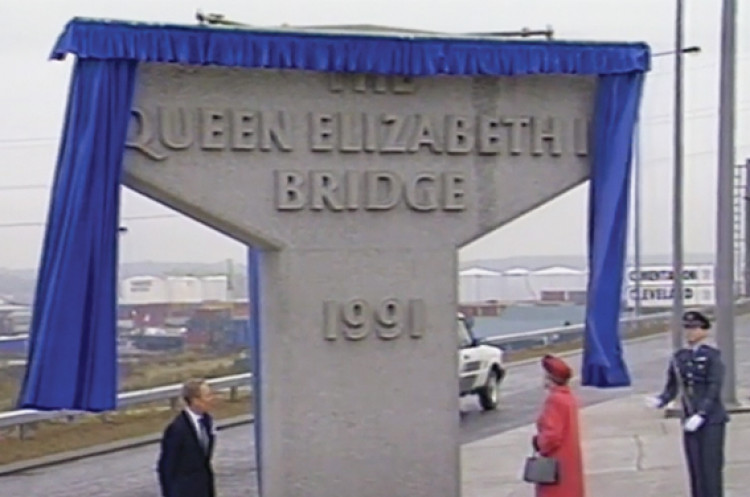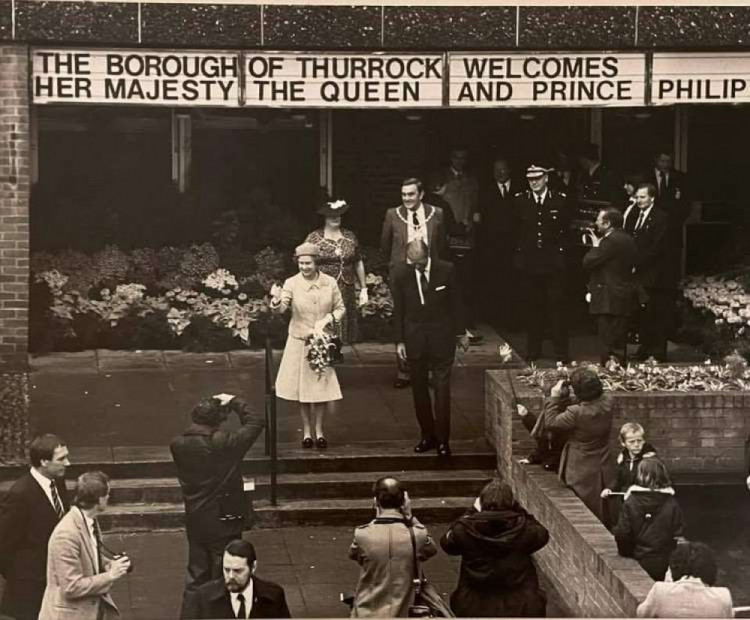Royal memories: The queen visited Purfleet and Tilbury after the great and disastrous floods in 1953
By Susan Yates - Nub News contributor 1st Jun 2022
By Susan Yates - Nub News contributor 1st Jun 2022
There's a right royal flavour to the latest in the occasional articles written for Thurrock Nub News by Susan Yates, chair of Thurrock Historical Society.
HERE we are in 2022 - Her Majesty Queen Elizabeth II's platinum jubilee year. With the Jubilee Bank Holiday weekend coming up so I thought I would write about Thurrock's Royal connections.
In 1988 the bridge at the Dartford Crossing was begun. It cost £120,000,000 to complete and at the time was the largest single span bridge in Europe measuring 2,872 metres in length.

It was officially opened by Queen Elizabeth on Wednesday, 30 October 1991.
Despite complaints, especially from Thurrock residents who wanted a Thurrock name, it was called the Queen Elizabeth II Bridge.
On the evening of Saturday 31st January 1953 Tilbury, Canvey Island and the east coast of England suffered severe flooding resulting in loss of life and much damage to property.
A look out at Coalhouse Fort located in a wooden hut on top of the search light emplacement noted that every minute after midnight the flooding became worse. The look-out kept his lamp beam on the water below the station because if the wall beneath gave way the station would collapse. He also noted seeing the bodies of two horses floating in the water. The water level was six feet above the normal spring tide level.
The rising water level left the look-out marooned. The incoming water entered Tilbury town from the east from Bill Meroy's Creek but this was not the only source of water as it was coming into the town from the Docks too.
The Queen came to visit Purfleet and Tilbury on Friday, 13 February 1953 to see the extent of the damage first hand.
She visited some of the houses which had been flooded and the Rest Centre at Lansdowne Road School, Tilbury. She was accompanied by Sir Francis and Lady Whitmore and presented to the Matron of Tilbury hospital, Miss Ross, the secretary of the hospital, and the Superintendent of St John Nursing Division, Grays. Her Majesty was taken to the nursery room where mothers and small children were waiting to greet her.

The Queen also visited Grays and the Thameside Theatre - a visit recalled in this link by another renowned local historian, Mike Ostler: https://thurrock.nub.news/news/local-news/when-the-queen-came-to-tea-ponies-flew-and-mike-got-his-old-suit-out-50-years-of-golden-memories-at-the-thameside-theatre
These were not the only times a Queen Elizabeth visited the Tilbury area.
8th August 1988 was the 400th anniversary of good Queen Bess's visit to West Tilbury. In the summer of 1588 Phillip of Spain organised a fleet or Armada of ships, he thought to be invincible, to conquer
England and force her to submit to Spanish rule. 130 ships left Spain on 12th July 1588 just seven days later beacons blazed on the English hillsides to announce the impending arrival of enemy ships.
The small and agile English naval ships intercepted the Spanish galleons as they sailed up the Channel and on 28th July English fire ships were let loose among the Armada as it lay anchored in Calais roads. This together with bad leadership from the inexperienced Admiral Medina Sidonia and poor weather led to the failure of the Armada expedition. Meantime troops had been assembling close to the Thames.
The exact location is uncertain but it is thought to have been somewhere in the Holford Road area, in West Tilbury.
The army under the command of the Earl of Leicester was intended to defend the Thames and ultimately London. It was here at West Tilbury that Queen Elizabeth I went amongst her troops and made her famous speech to stir them:
"Let tyrants fear. I have always so behaved myself that, under God, I have placed my chiefest strength and safeguard in the loyal hearts and good will of my subjects; and therefore I am come amongst you, as you see, at this time, not for my recreation and disport, but being resolved, in the midst and heat of the battle, to live and die amongst you all; to lay down for my God, and for my kingdom, and my people, my honour and my blood, even in the dust.
"I know I have the body but of a weak and feeble woman, but I have the heart and stomach of a king, and of a king of England too, and think foul scorn that Parma or Spain, or any prince of Europe, should dare to invade the borders of my realm! To which rather than any dishonour shall grow by me, I myself will take up arms, I myself will be your general, judge, and rewarder of every one of your virtues in the field."
It was once thought the Queen stayed with Thomas Rich at Arden Hall at this time but it is now believed she resided at Saffron Gardens, Horndon on the Hill with Edward Rich.
Belhus Mansion had its Queen Elizabeth's bedroom situated on the first floor of the south west corner above the south drawing room. There is no evidence to suggest that she ever spent the night there. However the family story has it that the room was prepared for her use when she breakfasted at the Manor.
Other than the story handed down through the family for generations there is no evidence to support this either. However, Belhus and the Barrett-Lennards do have a real connection with Royalty. At the coronation of George IV on 19th July 1821 at Westminster Abbey Sir Thomas Barrett-Lennard, the first baronet, was given the onerous task of guarding the door in order to stop George's wife Caroline of Brunswick from gaining entry to the Abbey and being crowned Queen. Being a true gentleman when she appeared he approached her and in the most courteous manner possible declined to allow her to pass.
I wonder how many more Royal connections Thurrock will have?
CHECK OUT OUR Jobs Section HERE!
thurrock vacancies updated hourly!
Click here to see more: thurrock jobs
Share:
















